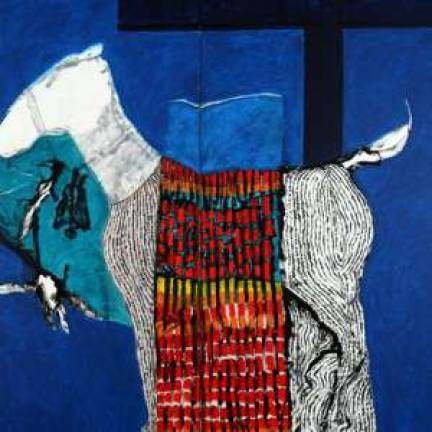By [Michaela Hirsch](http://cityarts.info/author/michaela-hirsch/) Peter Shaffer's 1974 Broadway Play, Equus, sparked within Israeli artist Moshe Givati memories of moving to Israel from Romania in the midst of World War II. Unable to speak Hebrew, at the age of five, Givati turned to painting as his only means of expression. Givati often painted horses, whose power and freedom restrained by man may have been metaphorically representative of his simultaneous desire (and inability) to be free as an artist and communicator. Years after seeing Shaffer's play in 1977, Givati was able to thoroughly channel and process this deep-rooted insecurity and frustration to establish himself as an artist. His exhibition at the Jadite Galleries in Clinton, "Equus Ambiguity ? Emergence of Maturity" is revealing of this mental torment. Characterized by violent images and blood reds juxtaposed with lines and crosses, his paintings suggest his inward battle between societal conformity and ultimate expression. Tragically, Givati died this April, only two months prior to the exhibition's opening. As curator Deena Lusky writes in her statement on display in each of the three rooms in the gallery, Givati was never quite able to answer for himself the question, "Does being "normal" in [our] culture entail losing one's individuality and learning to live without passion?" Throughout his artistic life, Givati was far from "normal," though he struggled to find his own "individuality" and "passion." Perhaps stemming from his insecurity in not fitting into the Israeli arts scene in New York throughout the 60s and 70s, Givati's disapproval of himself is overwhelmingly apparent in "Equus Ambiguity." Givati's paintings are marked by Xs, as he literally crossed-out many of his illustrations (or beginnings of illustrations). Specifically, in his two-canvas painting with an orange background, Givati depicted three horse heads, two of whose necks form a perfect perpendicular cross. On top of these solid shapes, Givati painted large Xs in red. In the remaining blank space, Givati used green and blue to form yet another X, which then covered this with even more red Xs. The crosses in this painting (as well as most paintings of the series) may represent Givati's mental block from fully executing an idea-in his practice generally (the intended cross in the horses' necks), and more specifically, in the red crosses atop his shapes. To read the full review at City Arts [click here. ](http://cityarts.info/2012/06/22/galloping-ambiguity/)

